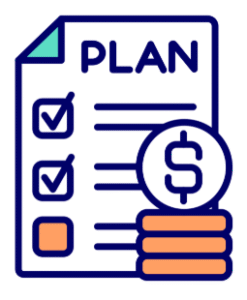Practical Steps

Financial security means feeling confident and in control of your money. It’s about having enough to cover your needs and wants, both now and in the future. Here are some practical steps to get you started:
1. Know Your Numbers:
- Track Your Income: Understand where your money comes from. List your salary, side hustles, and any other sources of income.
- Track Your Expenses: Monitor where your money goes. Categorize expenses (rent/mortgage, groceries, entertainment, etc.) and identify areas to cut back if needed. There are budgeting apps and spreadsheets to help.
- Calculate Your Net Worth: This is the total value of your assets (cash, savings, investments) minus your liabilities (debts). Track your net worth over time to see your progress.
2. Create a Budget:
- Set Financial Goals: What do you want to achieve with your money? Examples include building an emergency fund, saving for a down payment on a house, or a comfortable retirement.
- Prioritize Needs vs. Wants: Needs are essential expenses (housing, food, utilities). Wants are discretionary spending (entertainment, dining out). Allocate more towards needs and find creative ways to fulfill wants within your budget.
- The 50/30/20 Rule: This popular budgeting strategy allocates roughly 50% of income to needs, 30% to wants, and 20% towards savings and debt repayment. Adjust the percentages as needed to fit your circumstances.
3. Build an Emergency Fund:
- Aim for 3-6 Months of Living Expenses: Having this safety net helps cover unexpected costs like car repairs or medical bills without derailing your financial plans.
- Start Small & Automate Savings: Even $25 a week adds up. Set up automatic transfers from your checking to your savings account to build your emergency fund consistently.
4. Tackle Debt Strategically:
- High-Interest Debt First: Prioritize paying off credit cards and other high-interest debts first as they accumulate the most interest charges. Consider debt consolidation to simplify payments and potentially lower interest rates.
- Develop a Debt Repayment Plan: Choose a strategy that works for you. The snowball method tackles smaller debts first for quick wins, while the avalanche method focuses on high-interest debts first to save money overall.
5. Invest for the Future:
- Start Early & Contribute Regularly: Even small amounts invested consistently can grow significantly over time thanks to compound interest.
- Choose the Right Investment Vehicles: Consider your risk tolerance, investment timeline, and financial goals. Options include retirement accounts (401(k), IRAs), stocks, bonds, or mutual funds. Research and diversify your investments to spread risk.
6. Automate Your Finances:
- Set Up Automatic Savings & Bill Payments: Schedule automatic transfers to avoid missed payments and late fees. This helps you stay on track with your budget and financial goals.
7. Live Below Your Means:
- Resist Lifestyle Inflation: As your income increases, don’t automatically increase your spending. Allocate raises towards savings, debt repayment, or future goals.
- Embrace Frugal Living: Find creative ways to save. Explore free entertainment options, cook more at home, or consider downgrading unnecessary expenses.
8. Continuously Monitor & Adjust:
- Review Your Budget Regularly: As your income or expenses change, adapt your budget to maintain financial stability. Re-evaluate your financial goals and adjust your strategy as needed.
- Seek Professional Help (Optional): Financial advisors can provide personalized guidance and investment planning services based on your unique situation.
Remember, financial security is a journey, not a destination. By taking consistent steps and making smart choices, you can build a strong foundation for your financial future.

